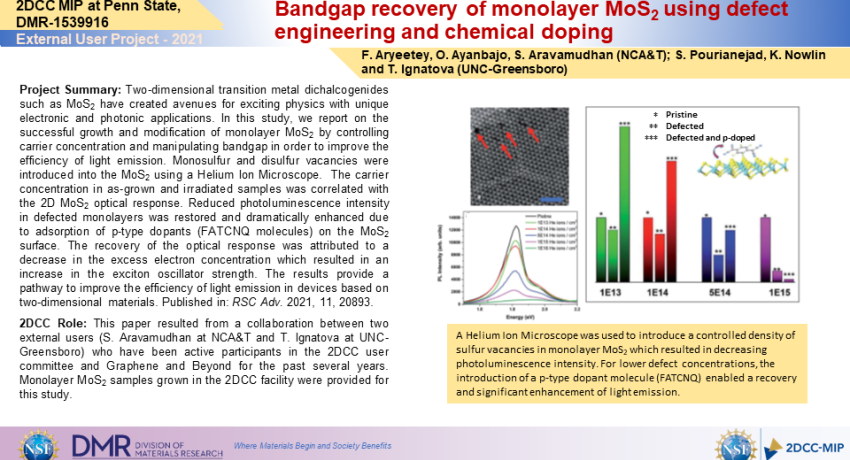Project Summary: Two-dimensional transition metal dichalcogenides such as MoS2 have created avenues for exciting physics with unique electronic and photonic applications. In this study, we report on the successful growth and modification of monolayer MoS2 by controlling carrier concentration and manipulating bandgap in order to improve the efficiency of light emission. Monosulfur and disulfur vacancies were introduced into the MoS2 using a Helium Ion Microscope. The carrier concentration in as-grown and irradiated samples was correlated with the 2D MoS2 optical response. Reduced photoluminescence intensity in defected monolayers was restored and dramatically enhanced due to adsorption of p-type dopants (FATCNQ molecules) on the MoS2 surface. The recovery of the optical response was attributed to a decrease in the excess electron concentration which resulted in an increase in the exciton oscillator strength. The results provide a pathway to improve the efficiency of light emission in devices based on two-dimensional materials. Published in: RSC Adv. 2021, 11, 20893.
2DCC Role: This paper resulted from a collaboration between two external users (S. Aravamudhan at NCA&T and T. Ignatova at UNC-Greensboro) who have been active participants in the 2DCC user committee and Graphene and Beyond for the past several years. Monolayer MoS2 samples grown in the 2DCC facility were provided for this study.
What Has Been Achieved: Controlled introduction of single and divacancy defects in monolayer MoS2 using a Helium Ion Microscope. This enabled a detailed study correlating defect density with the carrier concentration and optical properties of MoS2. Reduced photoluminescence intensity in defected MoS2 was restored and dramatically enhanced due to adsorption of p-type dopants (FATCNQ) on the MoS2 surface.
Importance of the Achievement: The results provide a pathway to improve the efficiency of light emission in devices based on two-dimensional materials.
Unique Feature(s) of the MIP that Enabled this Achievement: The paper resulted from a collaboration between two external users of the 2DCC including a minority-serving institution (NCA&T). Large area MoS2 monolayers grown in the 2DCC facility were used for some of the photoluminescence studies.
(If Applicable) Publication:
F. Aryeetey, S. Pourianejad, O. Ayanbajo, K. Nowlin, T. Ignatova and S. Arayamudhan, “Bandgap recovery of monolayer MoS2 using defect engineering and chemical doping,” RSC Adv. 2021, 11, 20893.
Part of this work was performed at the Joint School of Nano-science and Nanoengineering (JSNN), a member of the South-eastern Nanotechnology Infrastructure Corridor (SENIC) and National Nanotechnology Coordinated Infrastructure (NNCI), which is supported by the National Science Foundation (Grant ECCS-1542174). Some MoS2 samples for this publication was provided by The Pennsylvania State University Two-Dimensional Crystal Consortium – Materials Innovation Platform (2DCC-MIP), which is supported by NSF cooperative agreement DMR-1539916. Scanning Transmission Electron Microscope (STEM) imaging was conducted at the Center for Nanophase Materials Sciences, which is a DOE Office of Science User Facility.
